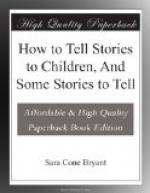But more distinctive and valuable than these, I think, is a specific use which I have recently had the pleasure of seeing exemplified in great completeness in the schools of Providence, Rhode Island.
Some four years ago, the assistant superintendent of schools of that city, Miss Ella L. Sweeney, introduced a rather unusual and extended application of the story in her primary classes. While the experiment was in its early stages, it was my good fortune to be allowed to make suggestions for its development, and as the devices in question were those I had been accustomed to use as a pastime for children, I was able to take some slight hand in the formative work of its adoption as an educational method. Carried out most ably by the teachers to whom it was entrusted, the plan has evolved into a more inclusive and systematic one than was at first hoped for; it is one from which I have been grateful to learn.
Tersely stated, the object of the general plan is the freeing and developing of the power of expression in the pupils.
I think there can be no need of dwelling on the desirability of this result. The apathy and “woodenness” of children under average modes of pedagogy is apparent to anyone who is interested enough to observe. In elementary work, the most noticeable lack of natural expression is probably in the reading classes; the same drawback appears at a later stage in English composition. But all along the line every thoughtful teacher knows how difficult it is to obtain spontaneous, creative reaction on material given.
Story-telling has a real mission to perform in setting free the natural creative expression of children, and in vitalising the general atmosphere of the school. The method in use for this purpose in Providence (and probably elsewhere, as ideas usually germinate in more than one place at once) is a threefold giving back of the story by the children. Two of the forms of reproduction are familiar to many teachers; the first is the obvious one of telling the story back again.
It is such fun to listen to a good story that children remember it without effort, and later, when asked if they can tell the story of The Red-Headed Woodpecker or The Little Red Hen, they are as eager to try it as if it were a personal experience which they were burning to impart.
Each pupil, in the Providence classes, is given a chance to try each story, at some time. Then that one which each has told especially well is allotted to him for his own particular story, on which he has an especial claim thereafter.
It is surprising to note how comparatively individual and distinctive the expression of voice and manner becomes, after a short time. The child instinctively emphasises the points which appeal to him, and the element of fun in it all helps to bring forgetfulness of self. The main inflections and the general tenor of the language, however, remain imitative, as is natural with children. But this is a gain rather than otherwise, for it is useful in forming good habit. In no other part of her work, probably, has a teacher so good a chance to foster in her pupils pleasant habits of enunciation and voice. And this is especially worth while in the big city schools, where so many children come from homes where the English of the tenement is spoken.




